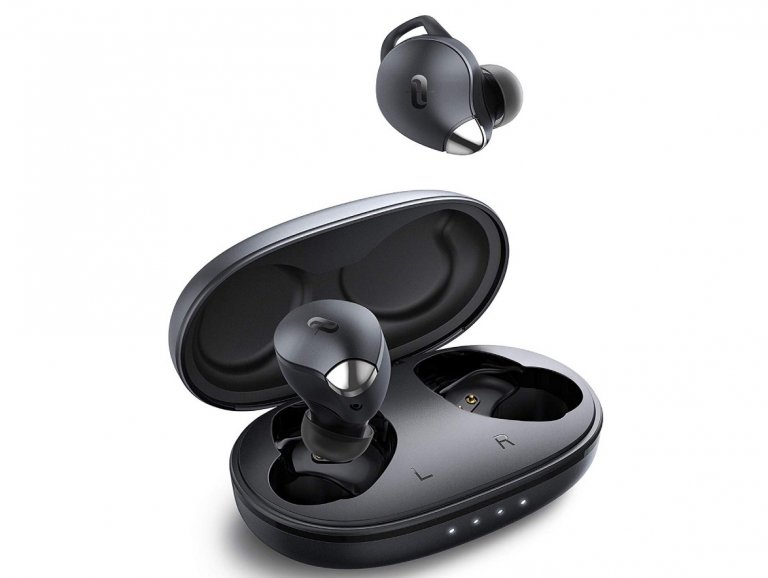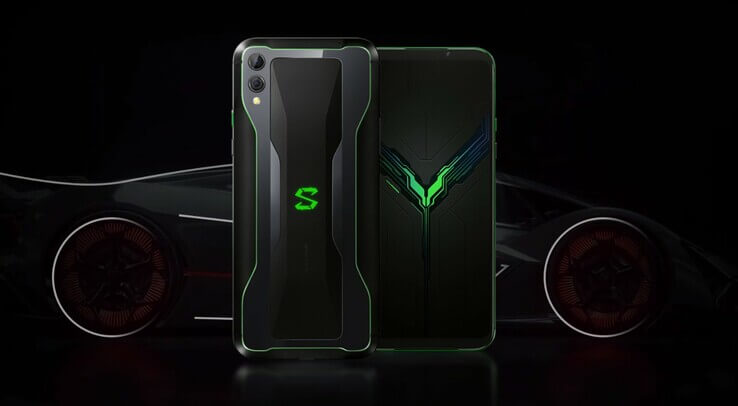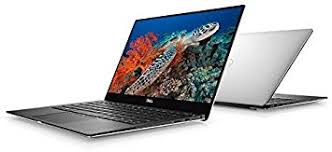Asus ROG Phone 3 Strix Edition review – gaming smartphone
Thoroughbred gamer : The ROG Phone goes into the third round and wants to score with powerful specs and special adjustments for players. Asus does a lot of fine-tuning compared to its predecessor. In this test, we clarify whether that is enough to survive against the increasing competition.
The Asus ROG Phone 3 starts in the Strix Edition tested here at 799 euros and then has 8 GB of RAM and 256 GB of internal storage. There is also a variant with 8/128 GB on the market, the large Strix version with 12 or 512 GB is reserved for the Asian market.
 Compared to the standard version of the ROG Phone 3, Strix users have to make do with the smaller Snapdragon 865 instead of the faster Plus model. In addition, up to 16 GB of RAM and 512 GB of UFS 3.1 are offered in this. Lastly, cellular modems are faster and support more communication bands.The main competitors of the ROG Phones are certainly the Black Shark 3 and the Red Magic 5G.
Compared to the standard version of the ROG Phone 3, Strix users have to make do with the smaller Snapdragon 865 instead of the faster Plus model. In addition, up to 16 GB of RAM and 512 GB of UFS 3.1 are offered in this. Lastly, cellular modems are faster and support more communication bands.The main competitors of the ROG Phones are certainly the Black Shark 3 and the Red Magic 5G.
Asus ROG Phone 3 Strix Edition (ROG Phone Series):
Processor: Qualcomm Snapdragon 865 8 x 2.4 – 2.8 GHz, Cortex-A77 / A55 (Kr yo 585)
Graphic card: Qualcomm Adreno 650
Main memory: 8192 MB, LPDDR5
Screen: 6.59 inches 19.5: 9, 2340 x 1080 pixels 391 PPI, capacitive touchscreen, 10 multi-Touch points, AMOLED, 270 Hz touch sampling rate, 25 ms touch latency, 2.5D Corning Gorilla Glass 6, glossy: yes, HDR, 144 Hz
Mass storage: 256 GB UFS 3.1 Flash, 256 GB, 236 GB free
Weight: 240 g, power adapter: 118 g
Price: 799 euros
Left: Asus homepage,Asus Notebooks overview page
Note: The manufacturer can use different components such as monitors, drives and memory modules with similar specifications under the same model name.
Case – ROG design with a lot of bulk:
The Asus smartphone weighs in at 240 grams, but is still comfortable to hold. There are no color options, all devices have the same design as their predecessor, only this time the manufacturer has completely dispensed with additional plastic applications. Instead, the back consists entirely of unspecified glass, with the illuminated ROG logo in the middle. The front is protected by Gorilla Glass 6.
We like the workmanship. The smartphone endures twisting attempts without a peep. However, the physical buttons can be moved a little and the gaps between the rear glass are not absolutely even, even if the differences are only noticeable on closer inspection.
The card slot can hold two nano SIM cards and the battery is firmly integrated in the smartphone. There is no special protection against the ingress of dust and water.
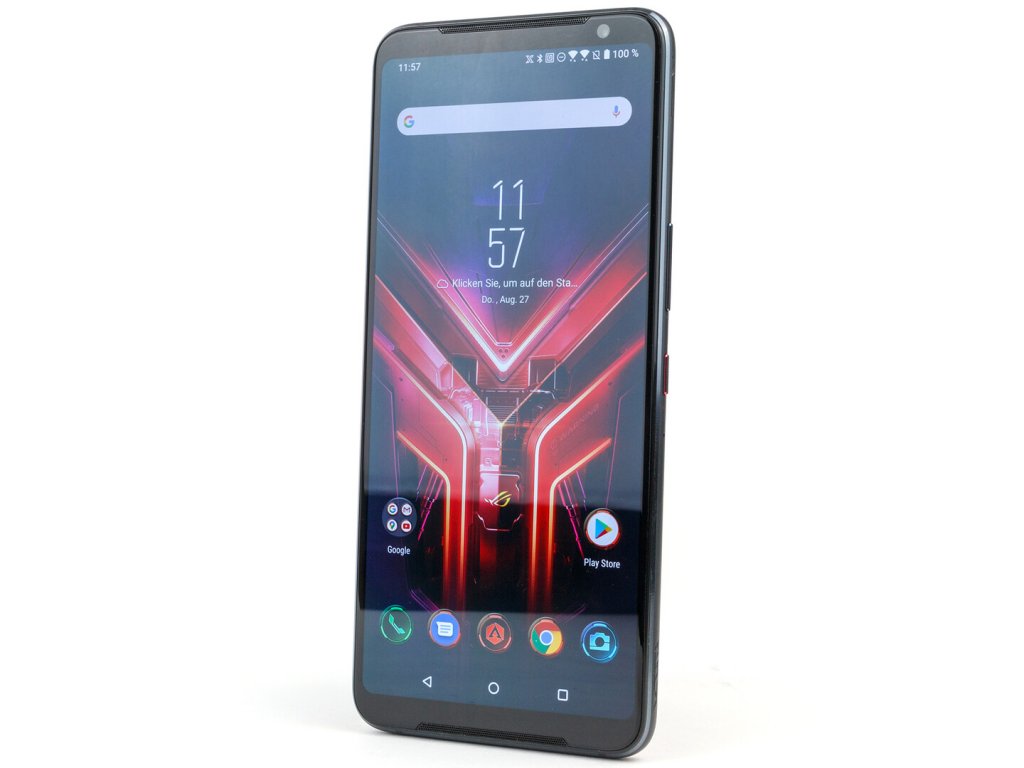
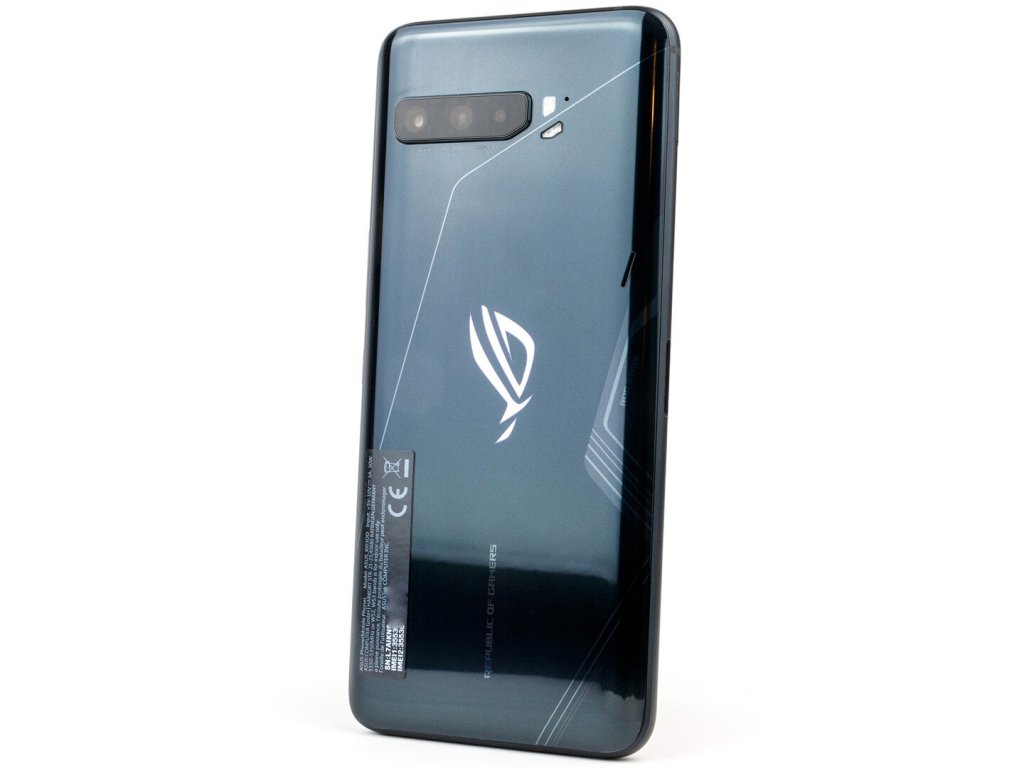
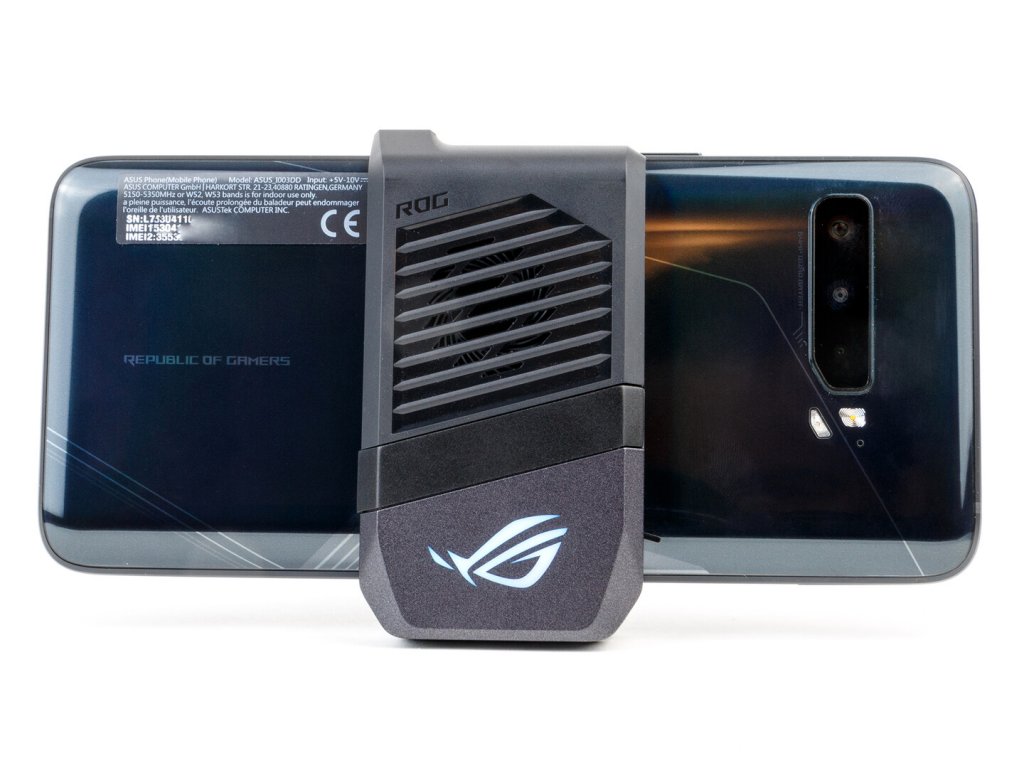
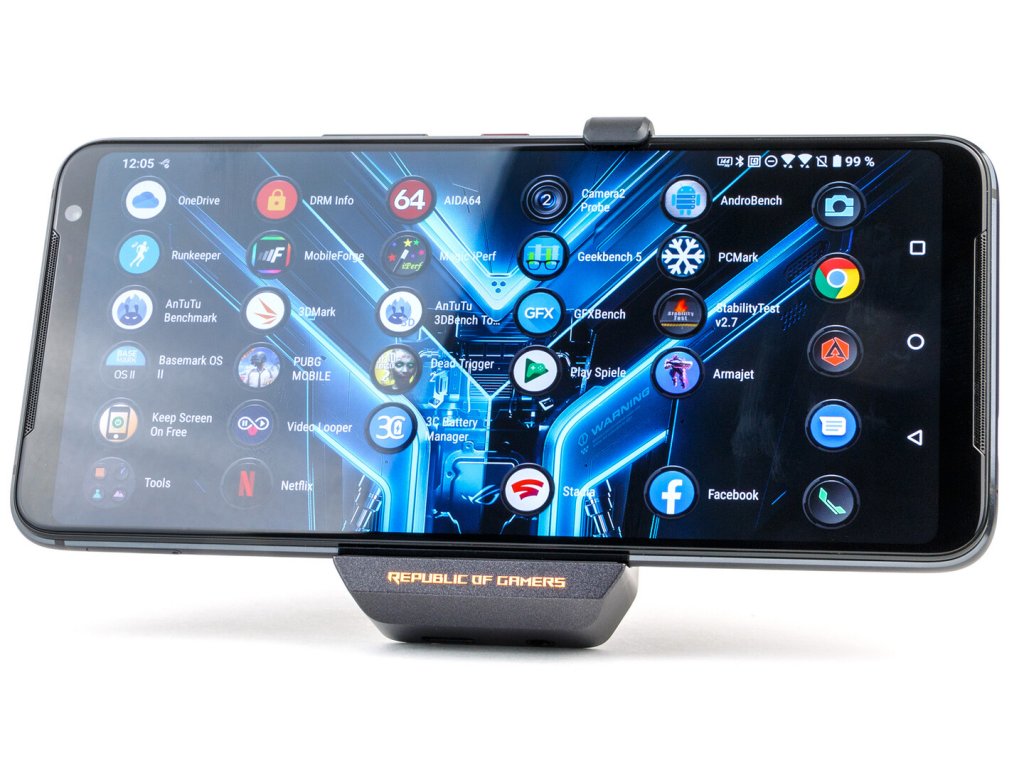

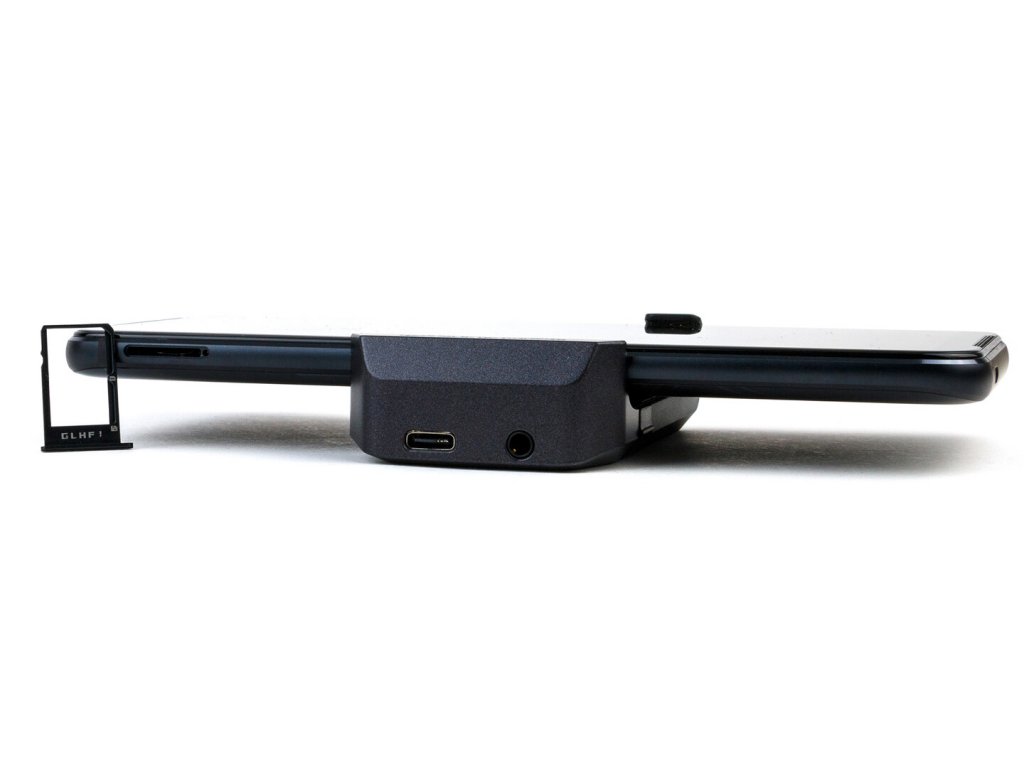
Features – AirTrigger 3 and two USBs:
When it comes to the interfaces, Asus does not spoil itself and treats the ROG Phone 3 with a USB and AeroActive Cooler port. In the latter there is also a USB 3.1 connection, which can transfer data particularly quickly (Gen. 2, 10 GBit / s) and also supports image output in UHD.


The AirTrigger buttons use ultrasonic sensors to detect applied pressure or contact. The two areas on the right long side are mainly used to control games, but the ROG Phone also supports pressing the smartphone as we already know from the Pixel 4, among other things. A short and long press can be used to start different actions, for example the X mode. However, this can be adjusted by the user.


The memory of the gaming smartphone cannot be expanded using a microSD card. Asus also doesn’t integrate an IR blaster or radio receiver. There is no audio jack on the smartphone itself; it is integrated into the clip-on cooler. Despite an always-on display, the smartphone also has a notification LED.
Software – Visually spiced up Android 10 with X-Mode:
The Asus ROG Phone 3 relies on Android 10, which at the time of the test had installed the security updates for July 1, 2020. The design has the classic gaming look again as we know it from its predecessors. Alternatively, however, a classic look can be chosen. The existing dark mode also works fine in third-party apps and can be configured in more detail in the settings.
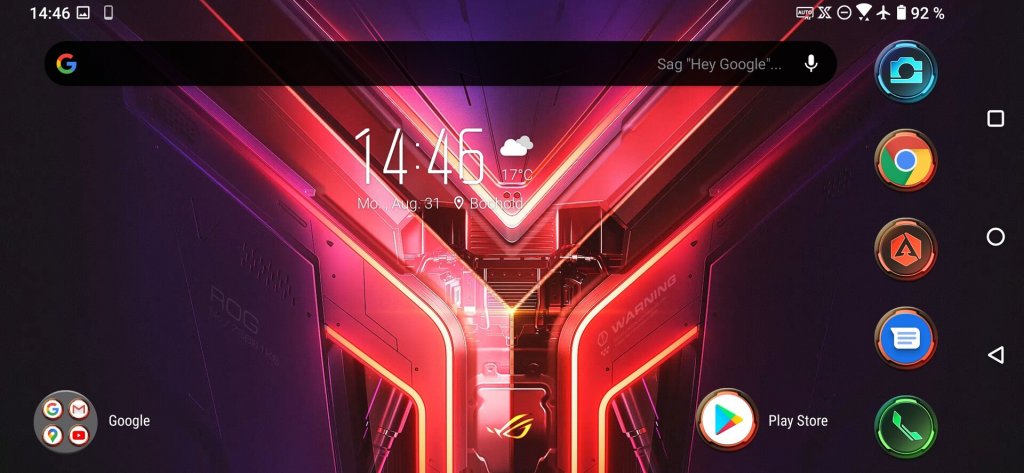
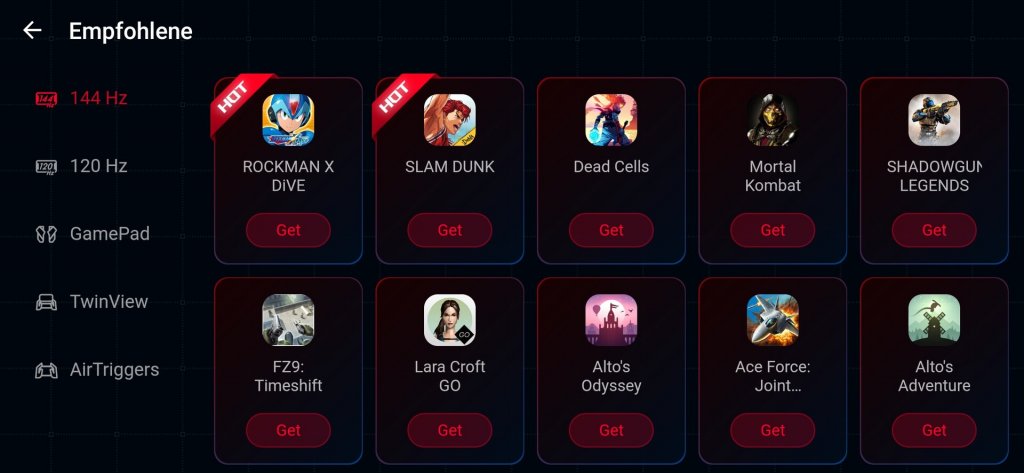
With the X-Mode the user receives useful tools with which he can completely trim the ROG Phone 3 for gaming. Annoying notifications can be blocked, the lighting controlled and the AirTrigger configured. In addition, the settings can be set individually for each game, be it the display refresh rate, the touch sensitivity or the network properties. The game recommendations also show titles that support either 120 or 144 Hz mode. A screen recording tool is also integrated directly into the system.
Communication and GNSS – 5G, Wi-Fi 6 and dual-band GNSS in the ROG Phone:
It should be positively emphasized that Asus does not hack into versions with LTE and 5G versions, but rather have all models of the ROG Phone 3 5G on board. However, the Strix Edition supports fewer frequency bands, namely only four instead of eleven. The theoretical transfer rates are also slightly lower and are used with LTE Cat. 18 (download: up to 1.2 Gbit / s, upload: up to 150 Mbit / s) or, in the 5G network, up to 4.0 Gbit / s should be possible for download and 542 Mbit / s for upload – a corresponding network is required. In terms of reception characteristics, the Asus smartphone behaved inconspicuously in the test.
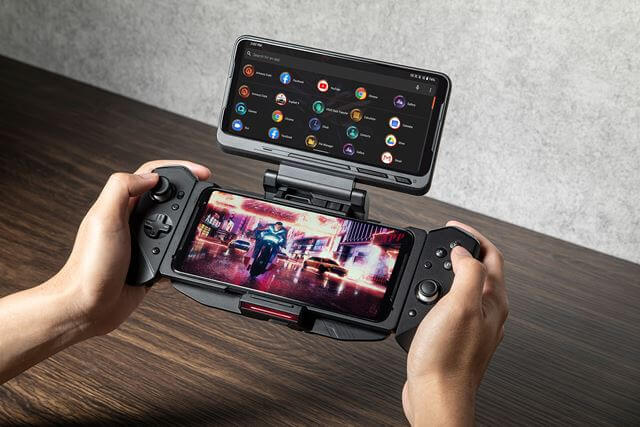
The WLAN module supports Wi-Fi 6 and in the test with our reference router Netgear Nighthawk AX12 proves to be very stable and with a good range. Only the sending of data is a bit weaker than expected. However, the ROG Phone also supports dual WLAN and can therefore connect to a second network simultaneously. This should not only increase the speed, but also further improve the stability.
Telephone functions and voice quality:
The telephony app of the Asus ROG Phone 3 is clearly laid out and offers a little surprise in the menu, because the smartphone supports the recording of calls. The dual SIM tray can hold two nano cards, only one of which can handle 5G. Options that underpin the support of Volt or WLAN calls cannot be found in the settings. In the past, Asus mostly provided support for the functions via an update.The voice quality is good as long as the ROG Phone 3 is held to the ear and ambient noise is properly filtered out. The smartphone echoes a bit in loudspeaker mode, which is not a problem in quiet surroundings.
Cameras – good setup in the ROG Phone 3:
The front camera offers a high resolution of 24 MP and uses pixel binning for better shots in low light so that a finished image is only 6 MP. At best, videos can be recorded in Full HD at 60 frames per second. The quality is quite decent, but the optics already iron out a lot of details without the portrait mode.

The centerpiece of the triple camera on the back is a Sony IMX686 sensor with 64 MP. In addition, there are ultra-wide-angle and macro optics. Zooming takes place exclusively digitally, but works quite well in the test due to the high number of pixels, but an eight-fold enlargement is the end. The ultra wide angle corrects lens distortion well, but the blurring in the edge areas increases visibly. The main camera delivers a balanced composition in daylight shots and does not overdo it with the sharpness. However, the colors should be a bit stronger in places. In the low-light area, the ROG Phone still captures a lot of light on the sensor, but this is at the expense of the details, which then often blur into a uniform color surface. The night mode should be positively emphasized at this point, which depicts the subject a little darker, but works out details finely.
The ROG Phone 3 can record videos with 8k (30 FPS) at best. But then you have to do without many functions and even in good light a slight noise can be seen.
Accessories and warranty – Strong scope of delivery for the ROG Phone:
Asus grants a 24-month guarantee on its smartphone. The scope of delivery includes a modular 30 watt power supply, a fabric-sheathed USB cable (Type-C to Type-C, 120 cm), a SIM tool, a jack adapter (USB-C to 3.5 mm), and a protective plastic frame as well as the AeroActive Cooler 3.
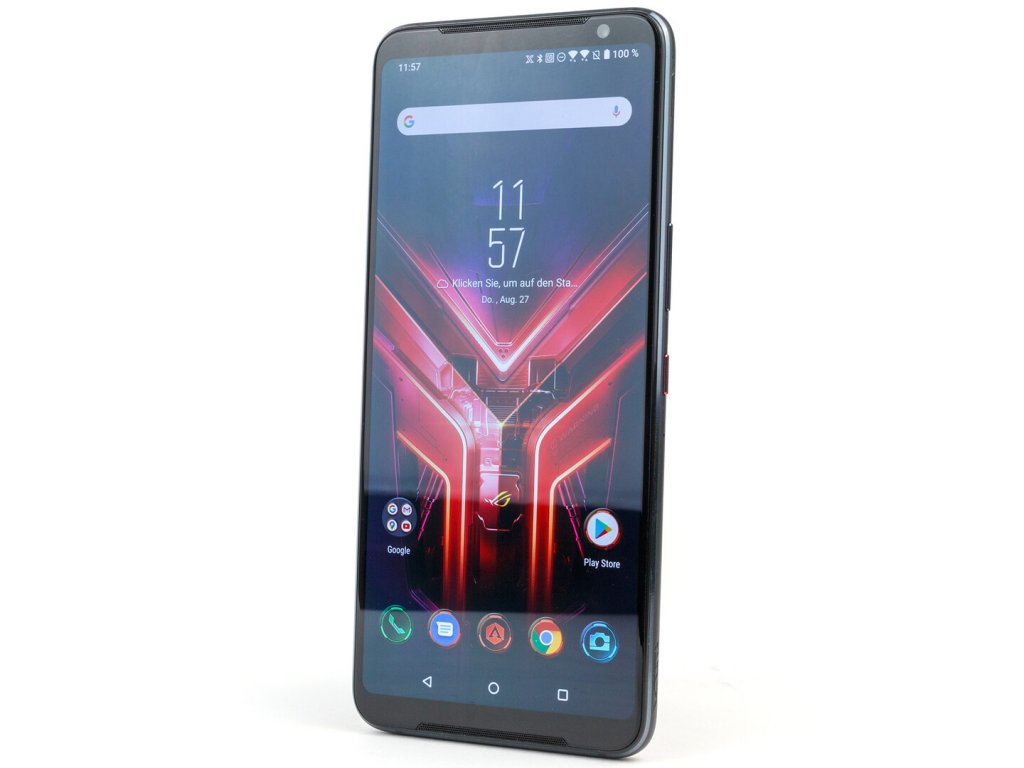
Asus offers additional accessories for the ROG Phone 3 in its online shop: including a desktop docking station (150 euros), with which the smartphone can be expanded with a screen (UHD), mouse and keyboard, as well as a Gigabit Ethernet Port and an S / PDIF output for 5.1 surround sound systems.
Input devices & operation – AirTriggers are not just for gaming:
The capacitive touchscreen of the ROG Phone 3 recognizes up to ten touches at the same time and impresses with its very good sliding properties and the quick implementation of inputs. The bio-metric security is guaranteed by a fingerprint scanner in the display, which performs reliably in the test and only rarely shows problems with recognition. Alternatively, a less secure 2D face recognition is available, which works much faster.

The ultrasonic touch sensors are located on the long sides of the smartphone and can also be used for system navigation. The default is to activate the X mode ‘with a long press, while a short squeeze activates the Google Assistant. In the settings, however, other functions or the start of any app can be selected.
We also really liked the haptic feedback of the Taptic vibration motor in the test.
Display – Always bright AMOLED in the Asus smartphone:
The data sheet of the ROG Phone 3’s display is very similar to that of its predecessor, only the higher refresh rate of up to 144 Hz is new. The AMOLED panel measures 6.59 inches (16.74 cm) diagonally and offers Full HD Plus resolution. The brightness has been slightly increased again and reaches a brightness of 625 cd / m² in the center of the picture with activated ambient light sensor. If this is switched off, it is already down at 416 cd / m². In the APL50 measurement with an even distribution of light and dark areas, up to 945 cd / m² are possible, which means that the display is well suited for reproducing HDR content and is consequently also certified for HDR10 and HDR10 +.
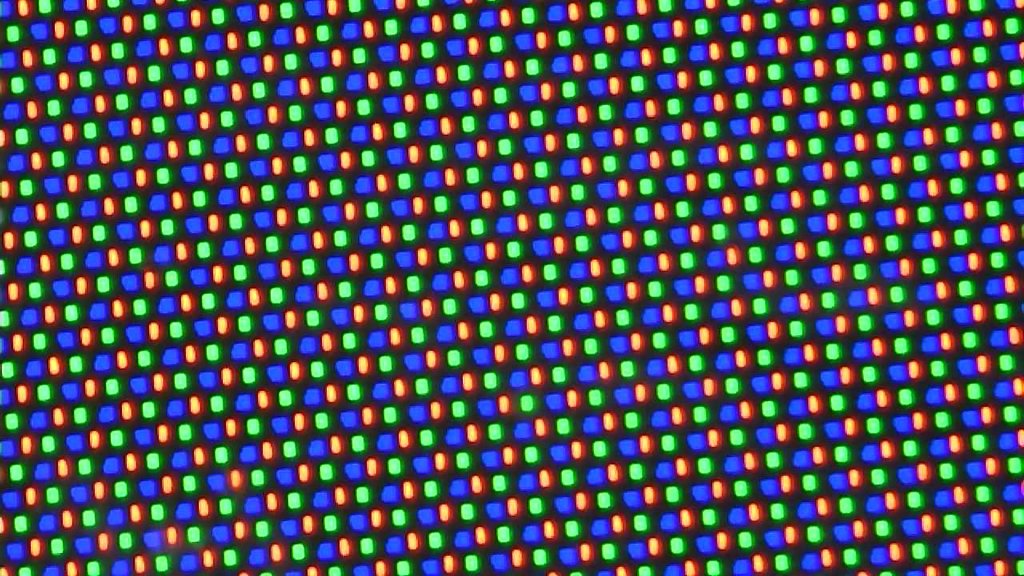
However, we noticed negatively the fairly high minimum brightness (10.25 cd / m²), which does not interfere with gaming, but if you would like to read something on the display in the evening, you will find that it is very bright.
As with other OLED panels, the ROG Phone’s typical OLED flickering occurs, which fluctuates between 123.8 and 255.1 Hz in 60 Hz mode. Correspondingly sensitive people can definitely feel this. The refresh rate can also be set in the settings, so that the panel can work at 60, 90, 120 or 144 Hz and the flickering is correspondingly more high-frequency.
595 629 662
cd/m2 cd/m2 cd/m2
590 625 660
cd/m2 cd/m2 cd/m2
615 627 670
cd/m2 cd/m2 cd/m2
X-Rite i1Pro 2
Maximum: 670 cd / m² Average: 630.3 cd / m² Minimum: 10.25 cd / m²
Illumination: 88%
Battery brightness: 625 cd / m²
Contrast: ∞: 1 (black value: 0 cd / m²)
ΔE Color 2.6 | 0.6-29.43 Ø5.8
ΔE Greyscale 2.5 | 0.64-98 Ø6
99.9% sRGB (Calman 2D)
Gamma: 2.22
Screen flickering / PWM (Pulse-Width Modulation):
A cheap way to control the brightness of a screen is to turn the lighting on and off periodically. This is called PWM (pulse width modulation). This switching should take place at a high frequency so that the human eye does not perceive any flickering. If the frequency is too low, this can lead to symptoms of fatigue, burning eyes, headache and also visible flickering.
Flickering / PWM detected 255.1 Hz ≤ 99% brightness.
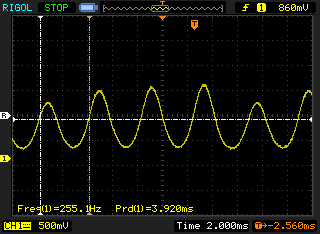

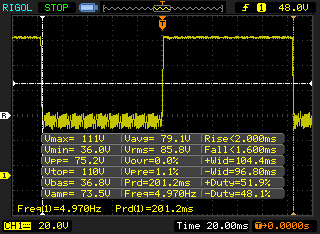
The display flickers at 255.1 Hz (most likely due to pulse width modulation PWM) with a set brightness of 99% and below. There should be no flickering above this.
The frequency of 255.1 Hz is relatively high and should therefore not cause any problems for most people. According to reports, sensitive users should perceive a flickering even at 500 Hz and above.
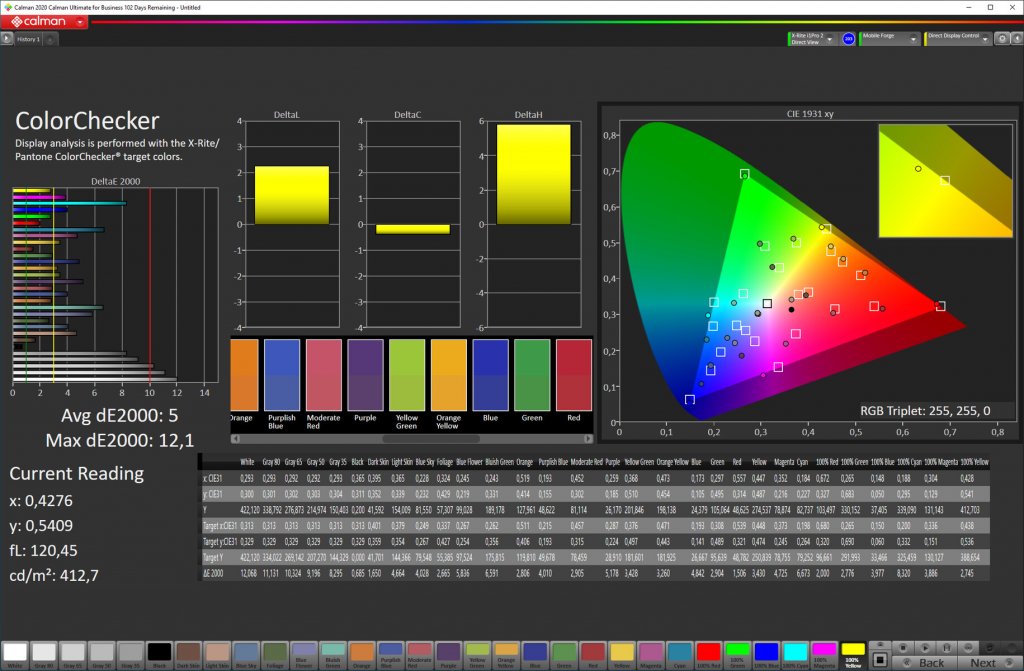
In comparison: 51% of all tested devices did not use PWM to reduce the brightness. If PWM was used, then at an average frequency of 17719 (minimum 5, maximum 2500000) Hz.
We checked the color display of the Asus ROG Phone 3 with the photo spectrometer and the CalMAN analysis software from Portrait Displays. The factory settings show both a large use of the color space and a very cool display. The colors are also very saturated. The Delta-E deviations from the target are correspondingly high.
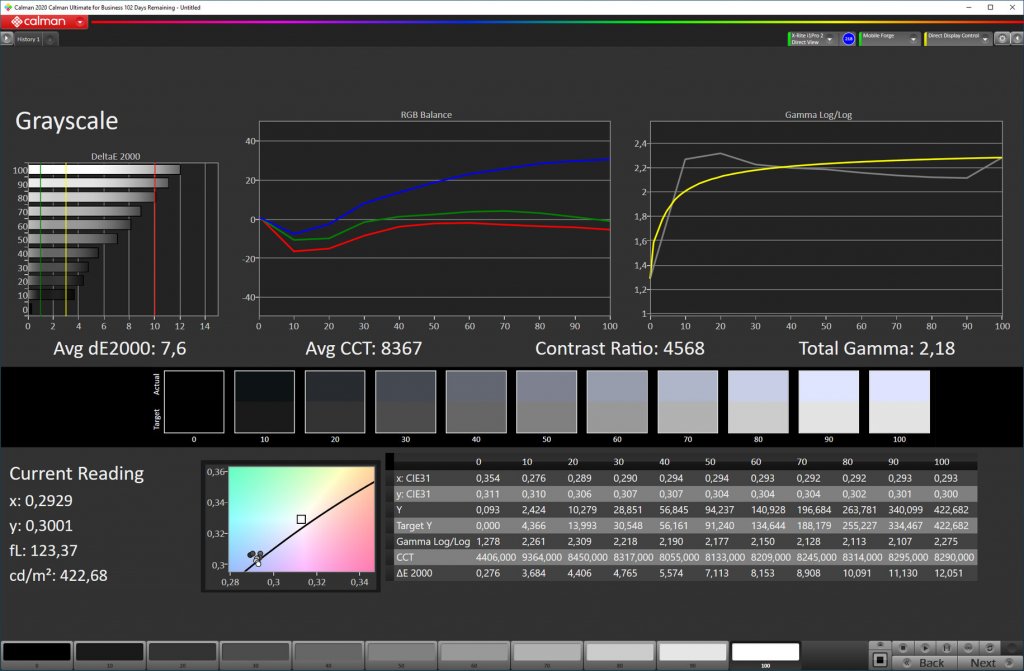
However, additional predefined profiles can be used via Splendid and both color temperature and saturation can be influenced. With the use of the smaller sRGB color space and a warmer white balance, the display becomes much more natural.

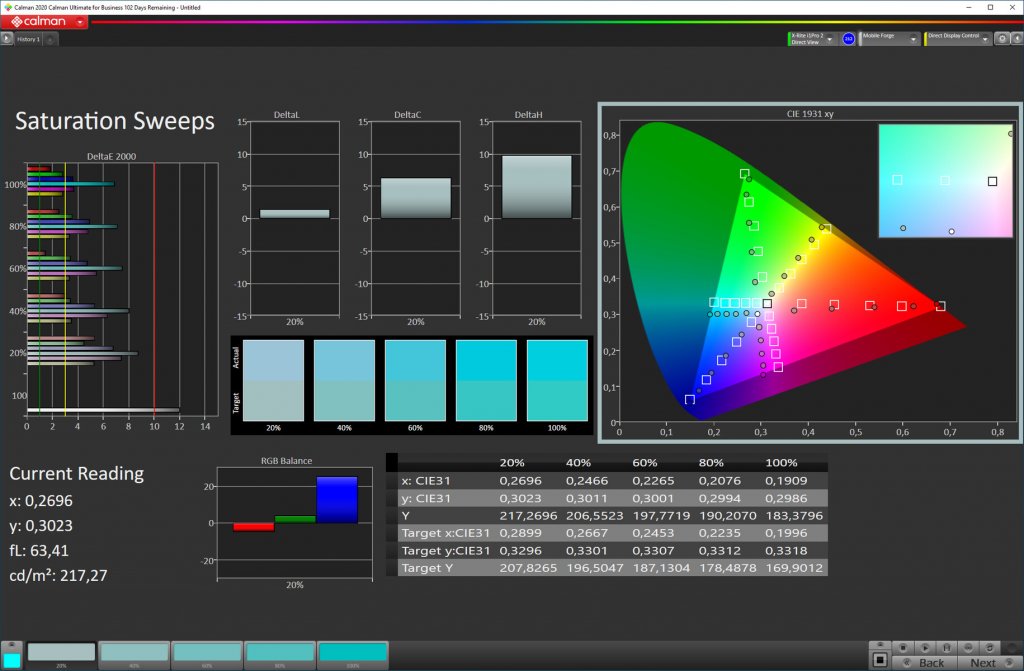
Response times of the display:
The response times describe how quickly it is possible to switch between two colors of a pixel. Slow response times can result in blurring, streaks, and ghosting. Short switching times are particularly important for fast 3D games.
↔ Black to white response times
2.4 ms … rise ↗ and fall ↘ combined ↗ 1.2 ms rise
↘ 1.2 ms fall
The measured response times are very short, which means that the screen should also be suitable for fast 3D games.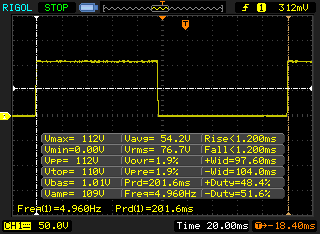
In comparison, the devices we tested ranked from 0.8 (minimum) to 240 (maximum) ms. »0% of all screens were faster than the tested one.
Therefore, the measured response times are better than the average of all measured devices (24.5 ms).
↔ Response times 50% gray to 80% gray
3.6 ms … rise ↗ and fall ↘ combined ↗ 2 ms rise
↘ 1.6 ms fall
The measured response times are very short, which means that the screen should also be suitable for fast 3D games.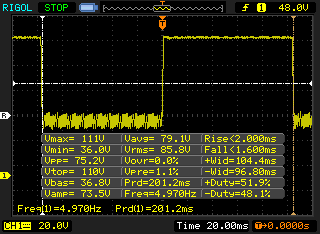
In comparison, the devices we tested ranked from 0.8 (minimum) to 636 (maximum) ms. »1% of all screens were faster than the tested one.
Therefore, the measured response times are better than the average of all measured devices (38.9 ms).
The ROG Phone 3 leaves a very good impression outdoors and has enough luminosity reserves to remain easy to read even on sunny days. It also impresses with its very low surface reflections.
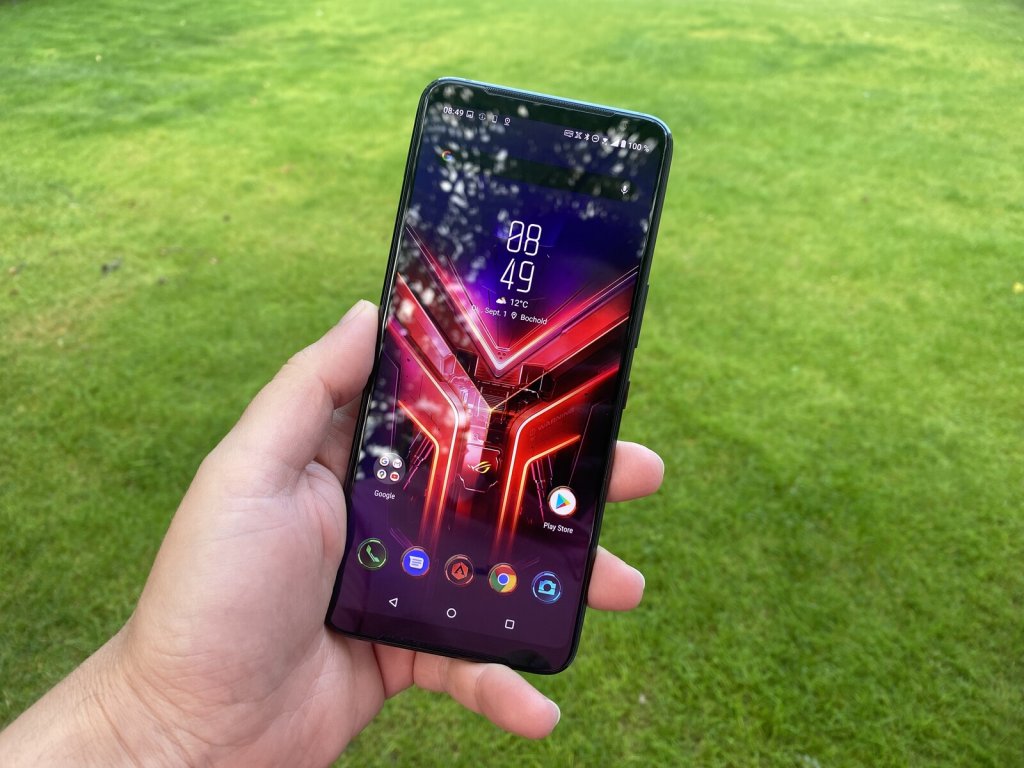
The viewing angle stability of the AMOLED display is very good, only at very flat viewing angles is there a slight decrease in brightness and a cooler display of the content.
Viewing angle stability
Performance – Strix Edition with Snapdragon 865:
In the Strix Edition of the ROG Phone 3, a Snapdragon 865 works with 8 GB of RAM. If you want more power under the hood, you have to use the more expensive Asus smartphone, which uses the faster Snapdragon 865+.
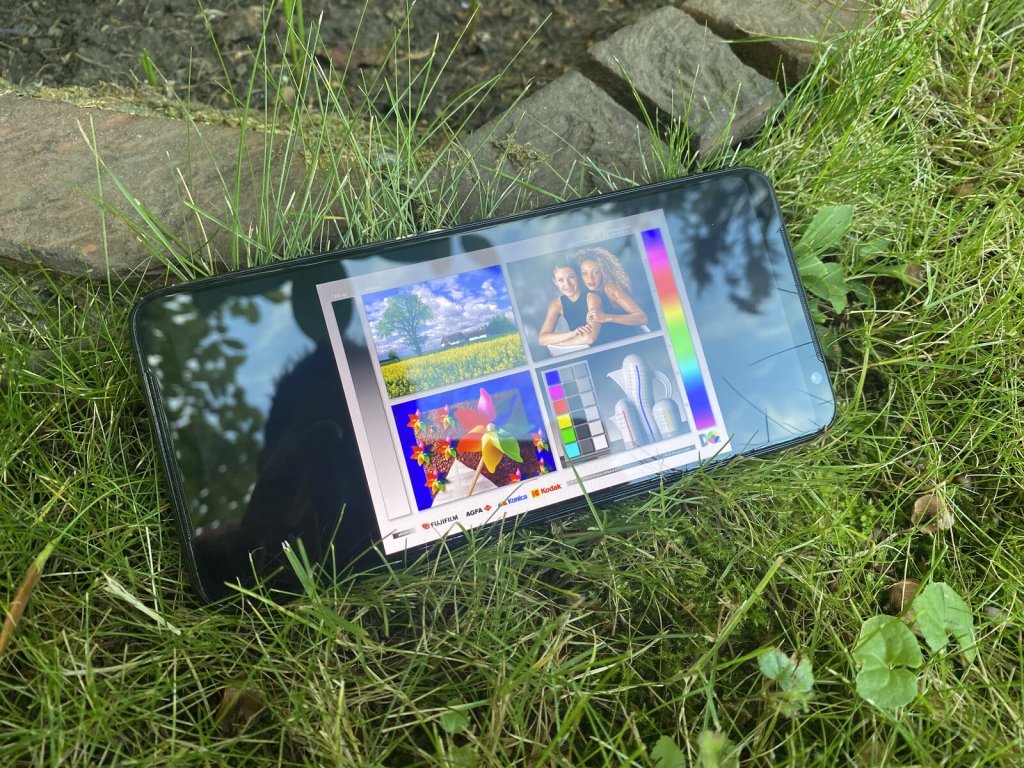 The ROG Phone is on the expected level in the benchmarks; the differences to the other gaming smartphones are only a few percent, which shouldn’t have any effect in everyday life. It will certainly be more interesting whether the power can also be used constantly, which we will clarify in the further course of the test.
The ROG Phone is on the expected level in the benchmarks; the differences to the other gaming smartphones are only a few percent, which shouldn’t have any effect in everyday life. It will certainly be more interesting whether the power can also be used constantly, which we will clarify in the further course of the test.
 Games – thoroughbred gamers:
Games – thoroughbred gamers:
The most important aspect of the ROG Phone 3 is certainly the gaming performance. Other smartphones with 120 or 144 Hz displays already exist, so this is not a unique selling point. But the support of the corresponding titles, because just because the hardware is available does not mean that the corresponding smartphone is also supported by the corresponding gaming studio. We have already noticed this with prominent representatives such as the Galaxy S20 Ultra, Oppo Find X2 Pro or the RedMagic 5G. This is exactly the point at which Asus can really boast, because the supported 144 Hz titles alone amount to over 200 (as of August 2020) – and the trend is rising.


We took a closer look at a few games with our partner GameBench. The performance-hungry PUBG Mobile works in every setting with a very stable 60 FPS, but unfortunately not more so far. In return, Asus Air features such as the AirTrigger come into their own, which can now record slipping and swiping gestures in addition to simple tap recognition. The setup is done quickly and the entries are implemented quickly. A real added value for everyone who likes to play on their smartphone.
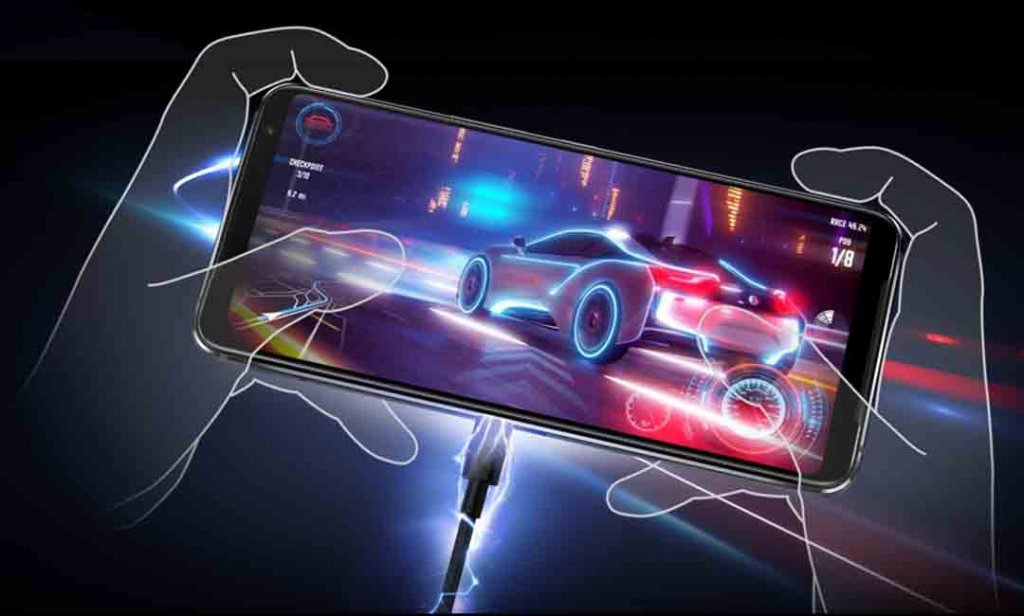
The game genius can also convince in the test, offers many setting options and can provide the user with information about the battery level, CPU / GPU usage, system temperature and the current refresh rate by means of a subtle display.
In simple titles like Dead Trigger 2, the 144 Hz can be played almost completely. With Armajet, however, there were never more than 120 FPS in it, it is quite possible that the Snapdragon 865+ will manage to squeeze the necessary ounce of power out of the smartphone in order to generate a few more FPS.
Emissions – efficient fan and good speakers:
Noise emissions
The smartphone as such does not have its own fan, but can plug it in. The AeroActive Cooler 3 can be controlled manually in four stages, alternatively the system can regulate this automatically.The fan can be heard well even at the lowest speed and gets quite loud with up to 47.7 dB (A) under full load.
Temperature:
On the back of the ROG Phone 3, part of the heat sink can be seen through the glass; the small opening nearby is used for air exchange. The surface temperatures stay below 28 ° C in idle, but rise noticeably under load and reach a peak of almost 37 ° C. If the fan is put on, the surface values change and the IR photos on the back clearly show that the warm air from the inside is blown away to the sides, which is perceived as cool on the hands.
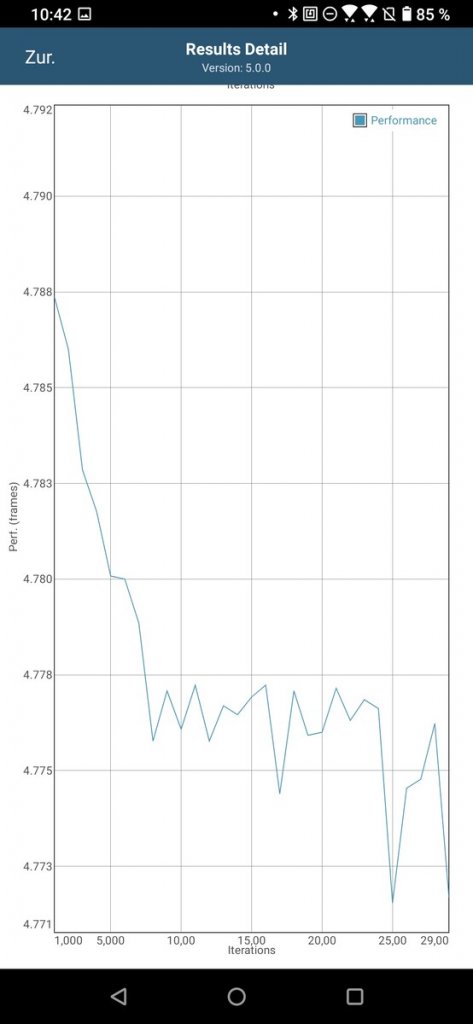
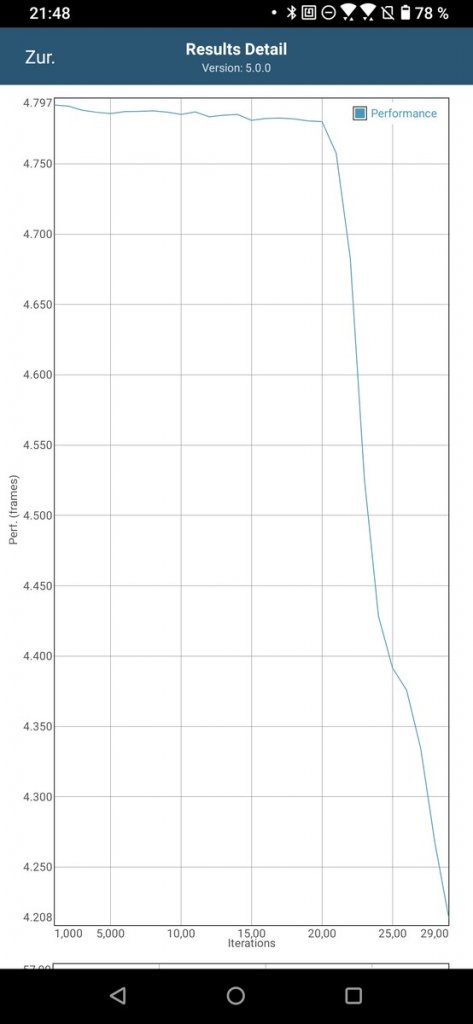
We use the GFXBench battery test to check the performance stability under constant load. We limit ourselves to the more demanding Manhattan test (OpenGL ES 3.1), which repeats the benchmark thirty times. The recorded frame values without a fan show a performance drop of a good twelve percent after the twentieth run. The values remain stable with the fan connected.
Speaker:
The two front-facing stereo speakers can make a lot of noise and also sound really good, even if the deep bass is completely missing.

Wired headphones can be connected via USB-C, a 3.5 millimeter jack adapter is included in the scope of delivery, which is unfortunately no longer a matter of course. If you use the ROG Phone with the fan, you can also use headphones with a jack plug. The analog connection impresses with a low-noise output and a signal-to-noise ratio of a very good 93.8 dBFS.
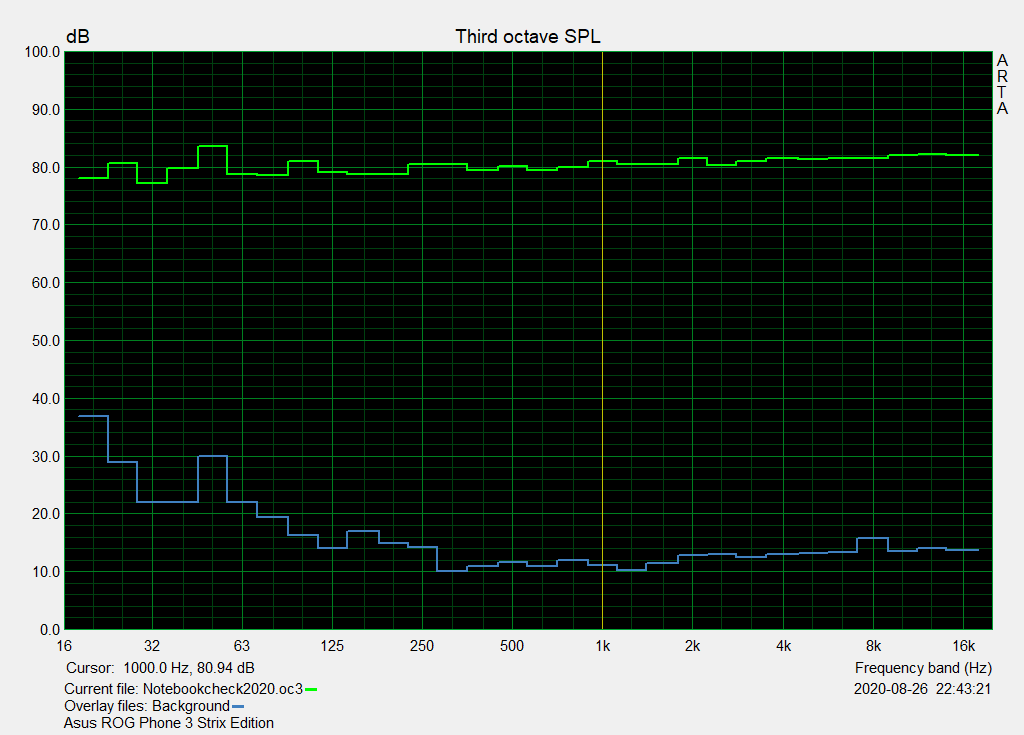
If you prefer wireless headphones or speakers, aptX Adaptiv is a very modern codec that promises low latencies and a wide range of sounds – provided the right counterpart is available. Alternatively, aptX, aptX HD and LDAC are also available.

Battery life
Energy absorption:
The power consumption of the ROG Phones is on an economical level, it is only comparatively high when the display brightness is minimal, which is due to the high minimum brightness. The higher refresh rate also takes its toll, as the measurements show. Because when idling, the smartphone needs 1.47 watts in 60 Hz operation at maximum brightness, which climbs to 1.59 watts at 90 Hz, 1.75 watts at 120 Hz and finally to 1.77 watts at 144 Hz.
The 6,000 mAh battery can be fully recharged within two hours using the included power supply unit. The Asus mobile phone supports QuickCharge 4.0 and PD, but no wireless charging.
Battery life:
Due to the largest battery in the comparison field, it was to be expected that the ROG Phone 3 would have the longest runtimes. Nevertheless, the lead is a bit narrower than expected in places, but that doesn’t change the fact that the runtimes are very good.
Battery life
Idle (without WLAN, minimum brightness)—–35h 04min
NBC WiFi Websurfing Battery Test 1.3 (Chrome 84)
16h 04min
Big Buck Bunny H.264 1080p
27h 54min
Load (full brightness)
5h 36min
Conclusion – Festival of Specifications:
The Asus ROG Phone 3 is also a smartphone in the Strix Edition that leaves little to be desired on the data sheet. The lack of wireless charging will be difficult to achieve in combination with the fan, and IP certification will also be difficult as long as the smartphone has a cooling slot – but we are happy to be taught better in the next generation.

The Asus ROG Phone 3 is convincing in many areas with a very complete range of features and is certainly the best gaming smartphone on the market at the moment.
Technically, the smartphone offers pretty much everything a gamer’s heart desires at the moment. These include a fast SoC, a responsive and bright 144 Hz HDR display, plenty of fast storage, good speakers, strong audio interfaces for headphones and plenty of optional accessories. Gadgets like the integrated LED lighting included.
However, the smartphone also has to accept criticism. On the one hand, there is the too high minimum panel brightness and, despite the very good battery life, the efficiency should be a bit better. If you also want to use VoLTE or WLAN calling, you will have to be patient, as this will probably be delivered via update. The cameras are good, but can’t keep up with current top models.

source: Review of the Asus ROG Phone 3 Strix Edition





